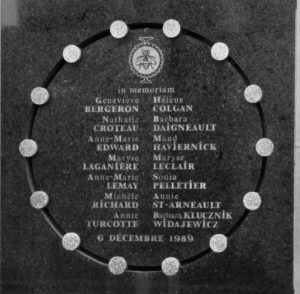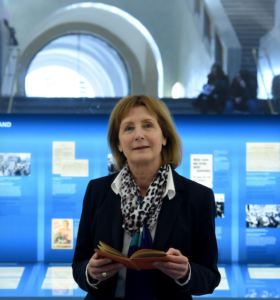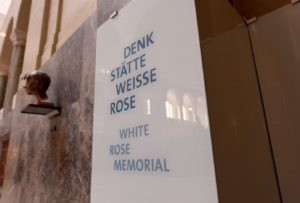26 May The White Rose (from 1943 to Today): Valour clothed in Gentleness – Part 2 of 2 by Michel Dongois
Let us continue our voyage into the history of the White Rose. This movement that fought to resist the regime in Nazi Germany can be a powerful source of inspiration for our times.
As the White Rose Impulse has long been a source of inspiration for me, I was invited to give a lecture and slide show on this theme to the Montreal members of the Anthroposophical Society in Canada in 1997. In the wake of my presentation, the Atelier d’art social de Montréal organized a participation workshop called The White Rose, a 20thCentury Manichean Quest.The idea behind the workshop was to discover a modern link to the spiritual realities hidden in the term “Manichean.”
A Manichean Quest
The prevailing concept today sees the two principles of good and evil as being in constant combat with one another – in the past, the present, and the future; but this concept gives us only a partial vision of the true situation, according to Denis Schneider, the Atelier’s founder. He goes on to say that in the Grail impulse and in the Faust story there is an aspiration towards transforming evil by realising that it is merely the good which is not in its rightful place and that the good must engage with evil in order to bring about a metamorphosis. “But the notion of answering evil with good is in its very essence a Christian impulse; it acts as a leaven in evolution.”
Denis Schneider points to what Rudolf Steiner brought as a new impulse; he encourages us to keep ourselves from falling into the good-evil duality by envisioning the situation in the form of a dynamic triad: the Representative of Man strides forward, in perfect balance, between Lucifer (who draws us towards the heights) and Ahriman (who drags us down into the depths). “Let us attempt to imagine the social artists of the White Rose movement by characterising the moral stature of the call to awakening they addressed to their fellow citizens. There was no personal will involved which would have made them feel superior. They had no desire to exert control over the freedom of thought of their fellow human beings.”
My slide presentation was followed by a workshop and conversation resulting in our coming to terms with the relationship between light and darkness. As we drew white roses on a black background, the reality of the play of light and darkness was revealed as if by magic. The darker we made the background, the lighter and brighter shone the white surface of the paper.
Denis then brought to our minds the image of ancient Greek soldiers, who, after having combed their long hair, breathed in the fragrant scent of a red rose to give them courage before battle. “As for the scent of the White Rose, we can imagine how it imbued the courage of the members of the movement with gentleness.” He also pointed out that the White Rose movement was born in 1943, at the same time that Saint-Exupéry was writingThe Little Prince.“Gentleness in the act of taming, respect for the rhythm of a non-violent approach – both of which are Manichean traits – were cultivated in the exchanges between the members. Good embraces; evil excludes.”
The Mothers of the Polytechnique Victims

The commemorative Plaque in front of the École Polytechnique in memory of the victims of the December 6, 1989 massacre.
Could the rose impulse have healing qualities? I wondered about this when I learned that the Montreal Polytechnique school, with no apparent connection to the events in Munich, created an Order of the White Rose in 2014. As a healing balm placed on the lingering wounds, these flowers appear at each commemoration of the shooting during which Marc Lépine, on December 6, 1989, killed 14 young women and wounded several others. Among its other activities, the Order of the White Rose awards scholarships every year to promising young female engineering students.
My work as a journalist led me to interview Monique Lépine, Marc’s mother, in 2013. “It took me 17 years to emerge from the mental abyss into which my son had plunged me.” This woman, who is a nurse, said how she cried for years. “Tears are the heart’s antifreeze; they keep it from hardening. I had hit rock bottom. I was completely helpless. Then, something supernatural happened.”
She took to contemplating the archetype of the Pieta, turning to Mary, who in Michelangelo’s sculpture is depicted suffering over the body of her son. “I prayed to Mary, asking her to ease my suffering and that of all the Polytechnique mothers.” She tells how she set out on a long “journey of restoration” that led to a spiritual healing. A network of human warmth (loved ones, colleagues, friends, and others) wrapped her in a mantle of caring. These people helped her lift herself up and at the same time, she adds, lift up her son. She had given her name to this son, who, at age 14, changed his name from Gamil Gharbi to Marc Lépine.
But that is when everything began to change, she explains. Name change; personality change. “Who was he trying to be? I knew my son Gamil Gharbi, but I did not know Marc Lépine. Why did he commit that terrible act?” Years later, Monique Lépine became active as an advocate for restorative justice. This citizens’ movement, which works within the penal system, seeks to “make whole again what has been torn apart by violence.” Through three-way meetings (inmates, victims, community members), the perpetrator is given the freedom to connect with the consequences of his actions, most often by experiencing the impact they have had on others.
Artists

Hildegard Kronawitter, president of the White Rose Foundation. (Source: Weisse Rose Stiftung e.V./ Catherina Hess).
Let us return now to Germany. What is the White Rose’s legacy today in 2019? I addressed this question to the White Rose Foundation (Weisse Rose Stiftung) in Munich. The Foundation’s president, Hildegard Kronawitter, responded: “We have a duty to keep the memory alive, in the spirit of Willi Graf’s farewell letter which said: Continue what we have begun.”
She pointed out that there are some 200 schools in Germany called Geschwister Scholl (honouring the Scholl siblings), and that there is a trend towards naming more schools after other members of the movement: Alexander Schmorell, Christoph Probst, Willi Graf, and more recently, Marie-Luise Jahn. Many cities have a street named in memory of the resistance movement: “From time to time we learn that another street has been renamed, especially after Sophie Scholl. Surveys indicate that she is a personality widely recognized and highly valued throughout Germany.”
The resistance movement continues to be a source of inspiration, especially for artists. The composer Udo Zimmermann was moved to compose an opera intitled The White Rose.The Foundation regularly receives requests for projects connected to the White Rose (cultural events, educational history projects). Traveling exhibitions journey throughout Germany and tour other countries as well. Historians and legislators have recognized the danger of allowing justice to be used to serve political power, as was so blatantly exemplified in the trials of the White Rose members.
Michaël
Nearly 30,000 young Germans and foreigners visit the University’s memorial each year: “Most of them have heard of the German resistance,  including the White Rose movement, at school. Sophie Scholl is a role model for many German girls and women. They admire her uncompromising courage as well as her clear, refined thinking.”
including the White Rose movement, at school. Sophie Scholl is a role model for many German girls and women. They admire her uncompromising courage as well as her clear, refined thinking.”
When I visited her place of birth, Forchtenberg, in 2012, I made my way to the Michaelskirche, where she was baptised. The church towers over the roofs of the city. At the Town Hall, I was given a miniature stained-glass window depicting the city’s emblem, Michael slaying the dragon. I learned that Germany’s oldest rose nursery, Rosenhof Schultheis, created a variety called Sophie Scholl in 2005. The very name and existence of this flower were created to keep awareness of the White Rose alive.
I asked whether the Foundation could provide an example of a contemporary initiative inspired by Sophie Scholl’s legacy. I was directed towards Sebastian Jelsch, a student at Ludwig-Maximilians University (LMU). He is making a guided tour available to the public via a mobile app. The itinerary takes the visitor through the Schwabing neighbourhood of Munich where the tragic events took place, and puts special emphasis on Sophie Scholl. He wrote me saying: “My hope is to encourage young people and ULM students to develop an interest in their university’s heritage.” A business administration student, Sebastian was inspired by a project developed by the prison of Alcatraz in the USA, where former inmates guide visitors on tours of the prison. “You had the feeling you were really there. That gave me the idea of making the narration as living as possible, with professional actors playing Sophie Scholl, professor Kurt Huber, and the others.”
He went on to say: “The White Rose gave us a powerful example of courage by rising up against hatred, injustice and discrimination.” Its members sacrificed their lives to defend what they believed in. “And so, we, who no longer have to fear for our lives if we disagree with the government, we must take action. I hope that this itinerary will serve to awaken awareness of the White Rose and inspire individuals to find peaceful ways of bringing about change.”
“The Dead continue their work …”
And what effect did the White Rose actually have at the time? As early as March, 1943, the writer Friedrich-Perceval Reck-Malleczewen, an opponent of Hitler who was executed in 1945, depicts the Scholls and their sacrifice in the following way: “…they seem to have planted the seeds of a movement that is continuing after their death.” In 1943, he wrote: “the dead are carrying on their work from beyond the tomb and their influence is bringing about a systematic breakdown of the Nazi administrative machine.” Was it the White Rose that inspired the courageous souls who, on July 20, 1944, attempted to overthrow Hitler?*
In her book “Long Live Freedom – Traute Lafrenz and the White Rose,” Traute asks: “What is a human being?” She goes on to say that to cultivate one’s humanity, is, among other things, to strive to find a way to “resist the hypnotic intoxication of the masses, to break away from the collective hypnosis in order to work towards free thinking. The White Rose followed this path, and if the Nazis were panicked by the movement, it is because the White Rose spoke the truth.”
The Russian Experience
“The more difficult the times, the closer we are to God,” wrote Willi Graf. Christoph Probst asked to be baptized just before being executed. Waging a non-violent combat, the circle of friends, having come together in complete freedom under the sign of the rose, proceeded steadfastly towards their meeting with Christ. And indeed, reading the writings of the Scholl siblings, one can sense how they reveal a gradual awakening to Christ, with whom they sought to develop a personal relationship, with the greatest possible clarity, in a state of melancholy and courage. The most decisive experience in this respect was certainly the six weeks Hans Scholl, Alexander Schmorell (who could speak Russian) and Willi Graf spent as medics on the Russian front, in the vicinity of Gzhatsk and Vyazma.
Their long strolls in the forest, their interaction with the peasants and villagers (they even formed a local choir), the vastness of the plains where the sky meets the horizon – all this made a deep impression on their souls. “I can clearly see how, above these defeated men and women, there hovers an angel that is stronger than the forces of nothingness that surround them.” These words were written down by Hans in his Russian Journal.* An idealistic view, perhaps, yet it is also an intuitive and free one, reminiscent of the Grail mood that, according to Sergei Prokofieff, is alive in the souls of Russian people.** In order to steep myself in this mood, in 1993, I visited Arkhangelsk, the city of the Archangel, located in the far Russian North, one of the rare cities that Stalin did not rebaptize. In a small group, led by a guide and a translator, we met with villagers dwelling in very isolated izbas in the surrounding area. We were welcomed with simplicity, warmth, humanness. In these places which seemed to me to be ageless, accessible only by muddy paths through the deep forest, I felt something of the diffuse spiritual call and longing that imbue the writings of the members of the White Rose.
And now?
After my interview with Traute Page, during which we spoke of the long past events of the resistance movement, she sent me this message: “I just could not pass up this card! It does express my delight in your article. My French gives me some limitations, but it seems to me this is about the best way to write about events that happened long ago. How are we going on? How do we preserve free human spirits who keep their judgment independent of what is going on around them and when necessary have the courage to express their different convictions?”
The question is still open.
Does the White Rose not help us strengthen our own hearts in such a way that we can be better prepared to confront the forces of Evil? Peter Selg*** ranks the members of the movement among the first initiates who, according to him, having recognized and confronted the Beast, crossed a significant threshold (the author quotes Rudolf Steiner and points to the year 1933). Two days before being arrested, Hans Scholl sent the following words to his friend Rose Nägele on February 16, 1943: “A gaping chasm opens up before me, and the darkest night shrouds my seeking heart, yet I persevere against all odds.” And he adds: “And as Claudel so beautifully put it: Life is a grand adventure towards the light.” *
*At the Heart of the White Rose: Letters and Diaries of Hans and Sophie Scholl (Paperback).
**Sergei O. Prokofieff, The Spiritual Origins of Eastern Europe and the Future Mysteries of the Holy Grail.
***Peter Selg, Der Geistige Weg von Hans und Sophie Scholl.


Sorry, the comment form is closed at this time.